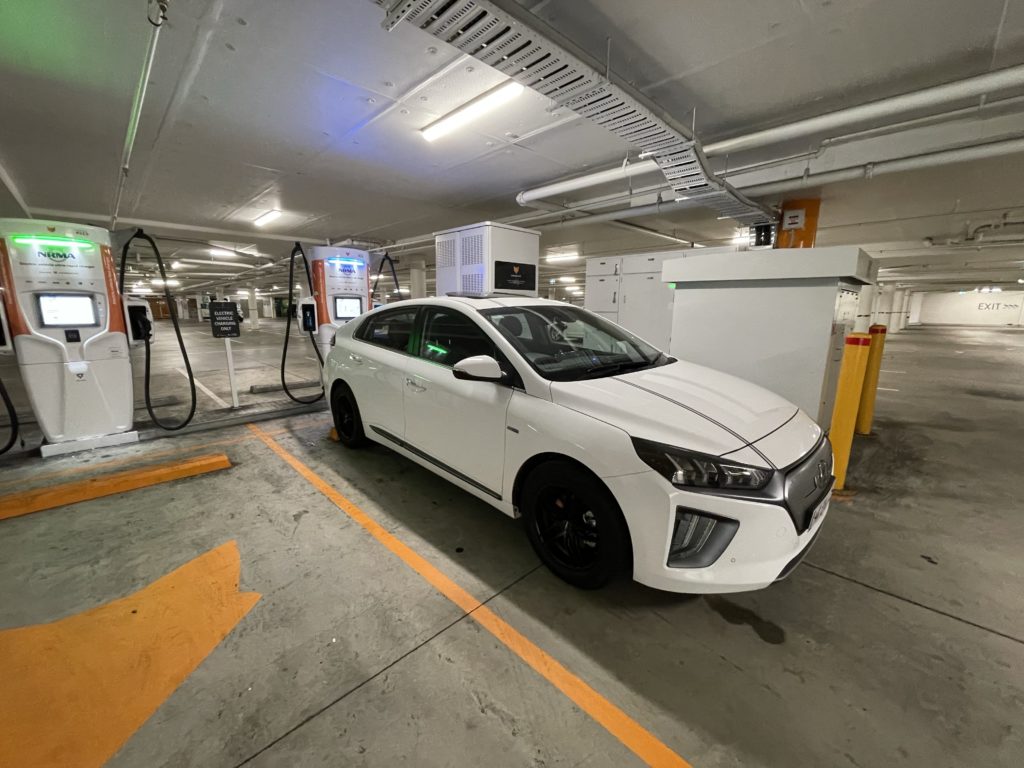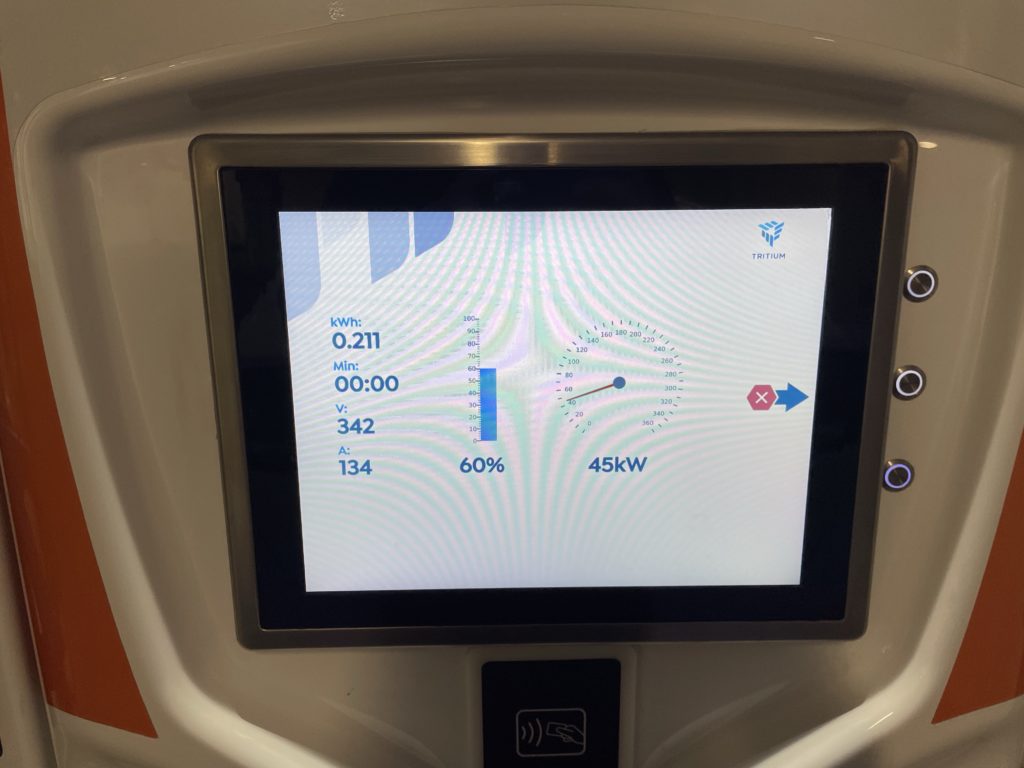Our Prime Minister used to say that electric cars will ruin the weekend, but now in 2021, he’s backflipped on that and pretty much denies having ever said it. It’s a good thing, too, because owning an electric vehicle (or EV) is getting easier and easier each week with new charging infrastructure popping up all over the place.
The last six months, I’ve driven a swathe of EVs (and reviewed a few of them on Ausdroid, too), before buying my own. No, I didn’t opt for a Tesla Model 3 with it’s anxiety-reducing 450km (or more) range, but I went for a Hyundai Ioniq EV, with a more modest 330km range (and a much more appealing price).
I have to admit, I too was worried about “range anxiety”, and whether a battery powered car that can’t recharge just anywhere would be able to meet my needs. Fortunately, I had the ability to do a fair bit of research before taking the plunge and decided that I could do it.
Rather fortunately, too, my typical drives don’t take a lot out of the car (or me), as most of my driving is around the Sydney metro area where – besides it being well within the range of my car – there’s an abundance of free and low cost chargers anyway. Just some of the places I’ve been in the last few weeks have had these – Westfield Chatswood? Free charger on the roof. Cherrybrook Village? Free charger underneath. Caddens Corner? Fast charger in the carpark, and while not free, it is pretty cheap.
If you drive further though, it’s only logical to worry about whether your car will make it there, or worse, back.
Fortunately, thanks to charger networks provided by the likes of the NRMA and Chargefox (to name but two, there’s plenty more) there’s a fast charger just about everywhere you’d need one (or nearby), and this makes your journey a pretty brain-dead exercise.
Last week, for example, I drove to Unanderra for work. From here, it’s around 150km each way, which – without a charge – would pretty much push the Ioniq’s range to the limit. With no charge, this would be a drive with no AC, keeping the speed under 100, and a fair bit of anxiety.
Fortunately though, there’s absolutely no need to do it this way.

Just around the corner from Unanderra (seriously, it’s about 10 mins away) there’s a NRMA / Chargefox 350kW fast charger at Shell Cove shopping centre and, at 7am, it wasn’t in use. In fact, I’d wager throughout most of the day it probably wouldn’t be in use. Still, I digress. Needing a coffee and something to eat after the 2 hour drive to get there, I was more than happy to go plug the car in and charge it for half an hour or so while I had some breakfast.
In all, this added about 45 minutes to my day … but it wasn’t an unwelcome addition. You see, if I’d driven a petrol car, I’d have gone straight to work and got into it, without a coffee and without breakfast. Instead, not only did the car get a charge, but I did too.

You might think a 350kW charger would charge the car much faster than this, but the Ioniq can only take a 50kW fast charge. Most cars won’t take much more than 100kW, so the 350kW is really just for marketing. Either way, with a 38kWH battery, a 50kW fast charger will take it from near empty to around 80% in about 45 minutes (but that last 20% will take a while longer, because it can’t charge as quickly without damaging the battery).
Better still, that charge which nearly filled the battery cost me just $6. If you nearly drain your fuel tank and need to re-fill it, it could easily cost nearly 10 times that … but it does have the advantage of taking around 5 minutes, as opposed to 45 minutes. Still, it’s a compromise I can work with.
All in all, I was at work by 8am, fed and caffeinated, and the car was nearly fully charged. With the help of a 10A socket at my destination, I could trickle charge the car for the rest of the day, leaving it fully charged for the drive home (and lightening the load on my home charger and power bill when I got back).
Another time, I did it slightly differently, driving down straight to site, without charging, and stopped in Picton on the way back where – you guessed it – there’s an NRMA fast charger free for the public to use. It, too, only took half an hour or so to top off the battery for the drive home, giving me ample time for a walk, a rest stop and a drink at a nearby hotel, before driving home.
This same story can apply literally anywhere; there’s fast chargers every 200km or so up and down the NSW coast and through much of central NSW too. The drive to Brisbane, for example, can be done with three stops (give or take) of around 45 minutes each. Considering it’s a long drive, this forces you to take a break from driving every two and a half hours or so, have a drink (or a coffee), something to eat, stretch your legs, then keep going.
In other words, what every driver should be doing anyway on such a long drive.
For me, I’d make it from Sydney’s northern suburbs to Taree, then to Coffs Harbour, then Coolangatta, then on to Brisbane. Each segment is around 270km or so, which – at freeway speeds – should be amply covered by the Ioniq’s 300-odd km range. If things do get a little tight, these aren’t the only places to charge on the way. There’s stops at Port Macquarie, Byron, Tyndale, and Macksville (to name but a few) and, depending on the time of day you’re driving, you’re likely to be able to charge at all of them.
While I haven’t actually done that drive yet (thanks to COVID and let’s face it, it’s a long drive) I do plan to, and this will be roughly the way I’d do it. Driving overnight makes the roads quieter, chargers more likely to be free, and funnily enough, makes it feel a little quicker too.
Far from ruining the weekend, EVs have probably made it safer with forced rest breaks on longer drives, and have done much to lighten the burden on our already over-worked environment thanks to the world’s addiction to fossil fuels.
Before you think about which public charging infrastructure you should use, you probably also want to have a think about how you’ll charge at home, too. Choosing a home charger isn’t difficult, and while there’s a few options, they broadly fall into two types:
- Single phase, 10A chargers – which probably come with your EV – which will charge your car at something around 2.0 to 2.4kW. With my Ioniq, a full charge would take 38.3kWh / 2.4 kW or at least 15.5 hours (though, in reality it charges slightly below 2.4kW, so a full charge time will be closer to 20 hours).
- Single phase, 32A chargers or three phase, 32A chargers which can deliver 7kW or 22kW from a household AC supply. There are a number of options and we’ll go into these in a future story, but choosing the right one for you is easy enough and the guys at Lightning Solar have a great EV charger guide to help you out.
If you too are considering an EV in your near future, here’s some apps you will need to help you plan your trip, charge up on the way, and make things easy:
- PlugShare – allows you to plan your trip according to your vehicle’s likely range, location of free/paid chargers, and ideally, which chargers are fast (i.e. 50kW DC or faster) or slower (up to 22kW AC).
- ChargeFox – has an extensive network of chargers in Sydney and around NSW, and while most are free, the paid ones are pretty cheap at around 30 – 40c per kWH. Some ChargeFox locations (all fast chargers) have cables supplied, while some you’ll need to BYO.
- ChargePoint – an older network, which still has quite a few chargers around but (a trap for new players) not all of them have the more modern Type 2 / CCS chargers. You may need to BYO cable and/or converter.
- Evie Networks – a much smaller network, but with key chargers in key locations, you’ll want to be a member so you don’t have to faff about when you arrive at one.
There are newer networks too, including Jolt (which has two chargers, one in Homebush and the other in Mona Vale) and Exploren (which has a few around Sydney and a few up the coast). These networks you’re less likely to use, but the thing I’ve found best is to open an account with all of them, so if you do arrive at a paid charger, you can sign in quickly and get charging instead of mucking around signing up.
However, with the 4 main apps listed above, you’ll be able to charge just about anywhere and get on your way!





Good article, but there are still two main hurdles to convince me that an EV is the all-rounder choice: The purchase price (still too high across all brands and options, should be on-par with combustion-engine powered vehicles) and the service life/replacement costs of the battery packs. This last one in particular, I haven’t seen any disclosures from the EV makers as to what the details are. Such significant servicing costs need to be disclosed to ensure buyers are making a fully informed decision
We need to look at whole of life costs when purchasing a vehicle, esepcially when the energy sources are not the same. The higher up front cost of an EV is substantially offset by reductions in recurring costs such as servicing and fuel. You absolutely do not need a EV to be on-par with an ICE vehicle to be ahead financially when you sell it.
Good choice of vehicle. I have the same one and don’t have range anxiety despite the relatively small range. Even heading out west a few weeks back and heading away from population earlier today. Does Chargepoint have any chargers in Aus? I thought they were North America only.
Also to echo what Richard said, the 350kW chargers can be used by some vehicles. Mostly the expensive ones at the moment, with the ranks soon to be joined by the Hyundai Ioniq 5 and Kia EV6, amongst others.
Thanks Wayne. I love the Ioniq and frankly the 330km range is perfect for me. I don’t think it’s small tbh; I mean, it IS but it doesn’t feel it.
ChargePoint definitely has chargers around Sydney. Grab the app and check it out.
All ChargePoint chargers in Australia should have been either taken over by Chargefox or decommissioned. ChargePoint pulled out of the market about 18 months ago.
Just gonna say, the 350kW ‘ultra fast’ charging is not ‘just marketing’. The Ioniq 5 and Porsche can today use 400kW, and more EV’s will move quickly to this.
As well as convenience, it makes sense for public chargers to offer ultra fast charging – less time that EV users need to share the same charger.